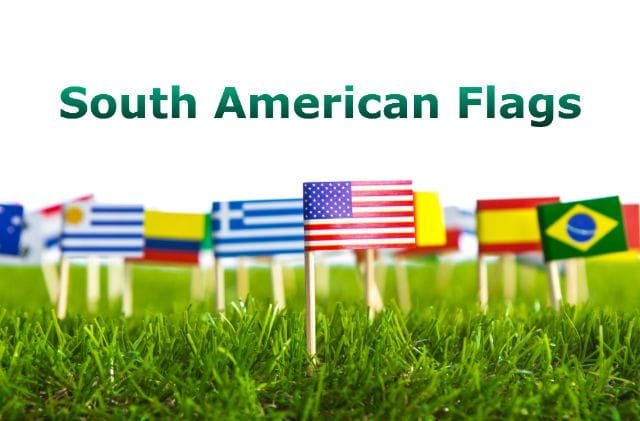Flags are more than just pieces of fabric; they are powerful symbols of a nation’s history, culture, and values. South American flags are rich in symbolism, each element telling a unique story of independence, heritage, and identity. From stars to suns and animals to colors, these symbols reflect the diverse history and spirit of the continent’s countries.
In this article, we’ll explore what each symbol on South American flags represents, helping you gain a deeper understanding of their significance.
Common Symbols in South American Flags
Many countries in South America share similar symbols on their flags, but each has its own specific meaning tied to national history and cultural identity.
1. Stars
Stars often represent administrative divisions such as provinces or states. For example, Venezuela’s flag features eight stars symbolizing its historical provinces. In Brazil, the stars depict constellations visible in the Brazilian sky, representing the country’s states.
Stars can also symbolize ideals such as freedom, unity, and guidance.
2. Sun
The sun is a frequent motif, symbolizing power, energy, and life. Argentina’s flag showcases the “Sun of May,” a golden sun with a face, representing the Incan sun god Inti and the May Revolution, a pivotal event in Argentina’s independence.
Similarly, Uruguay’s flag includes the Sun of May, highlighting shared heritage with Argentina and indigenous symbolism.
3. Animals
Several South American flags include animals as symbols of national fauna or cultural importance. Peru’s coat of arms features the vicuña, an animal native to the Andes and a symbol of freedom and natural wealth.
Colombia’s coat of arms contains the condor, representing strength and protection.
4. Plants and Trees
Flora also appears in flag symbols to represent natural resources and fertility. Peru’s coat of arms includes the cinchona tree, known for its medicinal properties. Ecuador’s flag similarly features a palm branch symbolizing peace.
5. Weapons and Tools
Some flags incorporate weapons or tools to symbolize defense and revolutionary history. Bolivia’s coat of arms includes muskets and an axe, reflecting the country’s fight for independence and resilience.
Color Symbolism in South American Flags
Colors play a fundamental role in conveying messages through flags.
- Red: Often symbolizes the blood of patriots, bravery, and sacrifice.
- Yellow (Gold): Represents wealth, resources, and the sun.
- Green: Symbolizes fertility, agriculture, and lush landscapes.
- Blue: Reflects the sky, rivers, and oceans.
- White: Denotes peace, purity, and unity.
Understanding these colors helps decode the deeper meanings behind South American flags.
Detailed Look at Selected South American Flags
Brazil
Brazil’s flag is one of the most symbolic in South America. The green background represents the lush forests, while the yellow diamond symbolizes gold and natural wealth. The blue globe with stars is a depiction of the sky over Rio de Janeiro on November 15, 1889, the date of the republic’s proclamation. The stars represent the country’s states and the motto “Ordem e Progresso” means “Order and Progress.”
Argentina
Argentina’s flag features three horizontal bands of light blue and white. The Sun of May in the center represents freedom and the birth of the nation. The blue and white colors are believed to represent the sky and clouds.
Colombia
The Colombian flag’s yellow band signifies the country’s riches and the sun, blue symbolizes the oceans, and red commemorates the blood shed for independence. The flag does not have additional symbols but carries deep meaning in its colors.
Venezuela
Venezuela’s flag is similar to Colombia’s tricolor but includes eight white stars arranged in an arc, symbolizing the country’s provinces. The red represents courage, yellow wealth, and blue the Caribbean Sea.
Peru
Peru’s flag consists of red and white vertical stripes. The red symbolizes the blood of heroes, while white stands for peace. The national coat of arms, often displayed on the flag, includes the vicuña, cinchona tree, and a cornucopia representing mineral wealth.
The Role of Symbols in National Identity
The symbols on South American flags do more than decorate; they unify citizens, celebrate shared heritage, and educate younger generations about their country’s origins. Flags fly proudly during national celebrations, sports events, and international gatherings, reminding people of their collective identity and history.
How These Symbols Inspire Beyond Borders
Many symbols in South American flags, such as the Sun of May or the condor, transcend national boundaries, reflecting common indigenous roots and regional solidarity. These shared symbols foster a sense of Pan-American unity while honoring each nation’s unique path.
Conclusion
Each element on South American flags is imbued with meaning — from stars to suns, animals to colors. Together, these symbols tell stories of independence, natural wealth, courage, and unity. Understanding these details enriches our appreciation of South America’s diverse cultures and histories.
Next time you see a South American flag, you’ll be able to recognize the powerful narratives woven into its fabric, making it not just a symbol but a story of a continent’s spirit.


